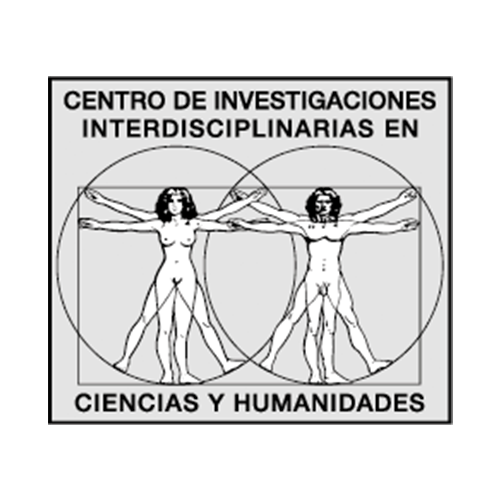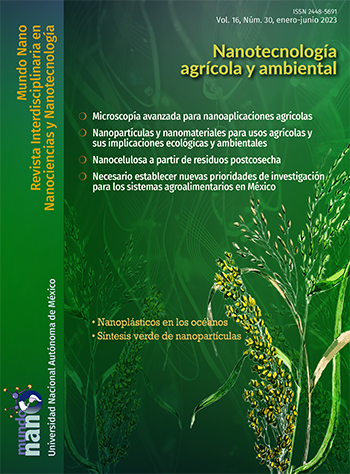Uso de nanomateriales en la agricultura y sus implicaciones ecológicas y ambientales
Contenido principal del artículo
Resumen
Los recientes desarrollos en el campo de la nanotecnología han traído nuevas oportunidades para la innovación y el avance en un número sustancial de disciplinas, entre las que destaca la agricultura. Los porcentajes actuales de inanición en todo el mundo, junto con el crecimiento constante de la población, combinados con los problemas ambientales causados por la erosión y el uso de productos químicos, han puesto en primer plano la necesidad de mejoras sostenibles en la práctica agrícola, que podrían atenderse empleando nanomateriales (NMs). Los NMs se presentan como un sustituto atractivo de los materiales convencionales, debido a sus atributos y la mejora que estos representan. Los pesticidas y fertilizantes son dos de los muchos productos que han demostrado tener un gran potencial cuando se producen a nivel nanométrico, mostrando gran eficiencia en la liberación dirigida y controlada de agroquímicos, lo que se traduce en una mayor efectividad biológica, al lograr, en general, un aumento en el rendimiento y la productividad de los cultivos. No obstante, aun existen aspectos desconocidos relacionados con los efectos de la nanotecnología, por ejemplo, existe un conocimiento limitado sobre la bioseguridad, los efectos adversos, el destino y la reactividad biológica de los nanomateriales una vez que se introducen en el medio ambiente. El daño que pueden causar, no solo a los agroecosistemas, sino también a la salud humana y al medio ambiente, aún no se comprende completamente, a pesar de los numerosos esfuerzos científicos que se han realizado para evaluar el peligro intrínseco que pueden causar los NMs. Esta revisión busca servir como marco referencial al estado de la nanotecnología en la agricultura: desarrollos, aplicaciones y riesgos conocidos. Se revisan las características de los NMs aplicados en agricultura, junto con los resultados obtenidos de las pruebas de comportamiento y destino con respecto a las especies vegetales. Finalmente, se analizan las interacciones reportadas entre los componentes bióticos y abióticos de los ecosistemas expuestos, presentando un estudio sobre el estado y la dirección de la nanoagricultura.
Descargas
Detalles del artículo

Mundo Nano. Revista Interdisciplinaria en Nanociencias y Nanotecnología, editada por la Universidad Nacional Autónoma de México, se distribuye bajo una Licencia Creative Commons Atribución-NoComercial 4.0 Internacional.
Basada en una obra en http://www.mundonano.unam.mx.
Citas
Abd El-Azeim, M., Sherif, M., Hussien, M., Tantawy, I., Bashandy, S. (2020). Impacts of nano-and non-nanofertilizers on potato quality and productivity. Acta Ecol. Sin., 40: 388-397. https://doi.org/10.1016/j.chnaes.2019.12.007. DOI: https://doi.org/10.1016/j.chnaes.2019.12.007
Abdelrasoul, M. A., Eid, A. R., Badawy, M. E. (2020). Preparation, characterizations and antibacterial activity of different nanoemulsions incorporating monoterpenes: in vitro and in vivo studies. Arch. Phytopathol. PFL, 53: 310-334. https://doi.org/10.1080/03235408.2020.1744977. DOI: https://doi.org/10.1080/03235408.2020.1744977
Alimohammadi, M., Panahpour, E., Naseri, A. (2020). Assessing the effects of urea and nano-nitrogen chelate fertilizers on sugarcane yield and dynamic of nitrate in soil. Soil Sci. Plant Nutr., 66: 352-359. https://doi.org/10.1080/00380768.2020.1727298. DOI: https://doi.org/10.1080/00380768.2020.1727298
Al-Juthery, H., Hardan, H., Al-Swedi, F. G., Obaid, M., Al-Shami, Q. (2019). Effect of foliar nutrition of nano-fertilizers and amino acids on growth and yield of wheat. Presented at the IOP Conference Series: Earth and Environmental Science, IOP Publishing, p. 012046. https://doi.org/10.1088/1755-1315/388/1/012046. DOI: https://doi.org/10.1088/1755-1315/388/1/012046
Al-Juthery, H., Saadoun, S. (2019). Fertilizer use efficiency of nano fertilizers of micronutrients foliar application on Jerusalem artichoke. Al-Qadisiya Journal for Agricultural Sciences, 9: 156-164. http://doi.org/10.33794/qjas.Vol9.Iss1.74. DOI: https://doi.org/10.33794/qjas.Vol9.Iss1.74
Ameen, F., Alsamhary, K., Alabdullatif, J. A., ALNadhari, S. (2021). A review on metal-based nanoparticles and their toxicity to beneficial soil bacteria and fungi. Ecotox. Environ. Safe., 213: 112027. https://doi.org/10.1016/j.ecoenv.2021.112027. DOI: https://doi.org/10.1016/j.ecoenv.2021.112027
Ashraf, S. A., Siddiqui, A. J., Abd Elmoneim, O. E., Khan, M. I., Patel, M., Alreshidi, M., Moin, A., Singh, R., Snoussi, M., Adnan, M. (2021b). Innovations in nanoscience for the sustainable development of food and agriculture with implications on health and environment. Sci. Total Environ., 144990. https://doi.org/10.1016/j.scitotenv.2021.144990. DOI: https://doi.org/10.1016/j.scitotenv.2021.144990
Badawy, M. E., Abdelgaleil, S. A., Mahmoud, N. F., Marei, A. E.-S. M. (2018). Preparation and characterizations of essential oil and monoterpene nanoemulsions and acaricidal activity against two-spotted spider mite (Tetranychus urticae Koch). Int. J. Acarol., 44: 330-340. https://doi.org/10.1080/01647954.2018.1523225. DOI: https://doi.org/10.1080/01647954.2018.1523225
Ben-Moshe, T., Frenk, S., Dror, I., Minz, D., Berkowitz, B. (2013). Effects of metal oxide nanoparticles on soil properties. Chemosphere, 90: 640-646. https://doi.org/10.1016/j.chemosphere.2012.09.018. DOI: https://doi.org/10.1016/j.chemosphere.2012.09.018
Bidi, H., Fallah, H., Niknejad, Y., Tari, D. B. (2021). Iron oxide nanoparticles alleviate arsenic phytotoxicity in rice by improving iron uptake, oxidative stress tolerance and diminishing arsenic accumulation. Plant Physiol. Bioch., 163: 348-357. https://doi.org/10.1016/j.plaphy.2021.04.020. DOI: https://doi.org/10.1016/j.plaphy.2021.04.020
Cao, C., Huang, J., Cai, W., Yan, C., Liu, J., Jiang, Y. (2016) Effects of silver nanoparticles on soil enzyme activity of different wetland plant soil systems. Soil Sediment. Contam. 26: 558-556. https://doi.org/10.1080/15320383.2017.1363158. DOI: https://doi.org/10.1080/15320383.2017.1363158
Chaud, M., Souto, E. B., Zielinska, A., Severino, P., Batain, F., Oliveira-Junior, J., Alves, T. (2021). Nanopesticides in agriculture: benefits and challenge in agricultural productivity, toxicological risks to human health and environment. Toxics, 9: 131. https://doi.org/10.3390/toxics9060131. DOI: https://doi.org/10.3390/toxics9060131
Chen, M., Sun, Y., Liang, J., Zeng, G., Li, Z., Tang, L., Zhu, Y., Jiang, D., Song, B. (2019). Understanding the influence of carbon nanomaterials on microbial communities. Environ. Int., 126: 690-698. https://doi.org/10.1016/j.envint.2019.02.005. DOI: https://doi.org/10.1016/j.envint.2019.02.005
Chhipa, H. (2017). Nanofertilizers and nanopesticides for agriculture. Environ. Chem. Lett., 15: 15-22. https://doi.org/10.1007/s10311-016-0600-4. DOI: https://doi.org/10.1007/s10311-016-0600-4
Christiaens, O., Petek, M., Smagghe, G., Taning, C.N.T. (2020). The use of nanocarriers to improve the efficiency of RNAi-based pesticides in agriculture, en: Nanopesticides. Suiza: Springer, 49-68. https://doi.org/10.1007/978-3-030-44873-8_3. DOI: https://doi.org/10.1007/978-3-030-44873-8_3
Dadi, R., Azouani, R., Traore, M., Mielcarek, C., Kanaev, A. (2019). Antibacterial activity of ZnO and CuO nanoparticles against gram positive and gram negative strains. Mater. Sci. Eng. C, 104: 109968. https://doi.org/10.1016/j.msec.2019.109968. DOI: https://doi.org/10.1016/j.msec.2019.109968
Das, S. K., Ghosh, G. K. (2021). Developing biochar-based slow-release NPK fertilizer for controlled nutrient release and its impact on soil health and yield. Biomass Convers. Biorefin., 1-13. https://doi.org/10.1007/s13399-021-02069-6. DOI: https://doi.org/10.1007/s13399-021-02069-6
Dimkpa, C.O. (2018). Soil properties influence the response of terrestrial plants to metallic nanoparticles exposure. Curr. Opin. Environ. Sci. Health, 6: 1-8. https://doi.org/10.1016/j.coesh.2018.06.007. DOI: https://doi.org/10.1016/j.coesh.2018.06.007
Diyanat, M., Saeidian, H., Baziar, S., Mirjafary, Z. (2019). Preparation and characterization of polycaprolactone nanocapsules containing pretilachlor as an herbicide nanocarrier. Environ. Sci. Pollut. R., 26: 21579-21588. https://doi.org/10.1007/s11356-019-05257-0. DOI: https://doi.org/10.1007/s11356-019-05257-0
Ellegaard-Jensen, L., Jensen, K. A., Johansen, A. (2012). Nano-silver induces dose-response effects on the nematode Caenorhabditis elegans. Ecotox. Environ. Safe., 80: 216-223. https://doi.org/10.1016/j.ecoenv.2012.03.003. DOI: https://doi.org/10.1016/j.ecoenv.2012.03.003
El-Shetehy, M., Moradi, A., Maceroni, M., Reinhardt, D., Petri-Fink, A., Rothen-Rutishauser, B., Mauch, F., Schwab, F. (2021). Silica nanoparticles enhance disease resistance in Arabidopsis plants. Nat. Nanotechnol., 16: 344-353. https://doi.org/10.1038/s41565-020-00812-0. DOI: https://doi.org/10.1038/s41565-020-00812-0
Faizan, M., Faraz, A., Yusuf, M., Khan, S., Hayat, S. (2018). Zinc oxide nanoparticle-mediated changes in photosynthetic efficiency and antioxidant system of tomato plants. Photosynthetica, 56: 678-686. http://doi.org/10.1007/s11099-017-0717-0. DOI: https://doi.org/10.1007/s11099-017-0717-0
Fukase, E., Martin, W. (2020). Economic growth, convergence, and world food demand and supply. World Dev., 132: 104954. https://doi.org/10.1016/j.worlddev.2020.104954. DOI: https://doi.org/10.1016/j.worlddev.2020.104954
Ge, Y., Schimel, J. P., Holden, P. A. (2011). Evidence for negative effects of TiO2 and ZnO nanoparticles on soil bacterial communities. Environ. Sci. Tech., 45: 1659-1664. https://doi.org/10.1021/es103040t. DOI: https://doi.org/10.1021/es103040t
Ge, Y., Schimel, J. P., Holden, P. A. (2012) Identification of soil bacteria susceptible to TiO2 and ZnO nanoparticles. Appl. Environ. Microbiol. 8: 6749-6758. https://https://doi.org/10.1128/AEM.00941-12. DOI: https://doi.org/10.1128/AEM.00941-12
Giroto, A.S., Guimarães, G. G., Foschini, M., Ribeiro, C. (2017). Role of slow-release nanocomposite fertilizers on nitrogen and phosphate availability in soil. Sci. Rep., 7: 1-11. https://doi.org/10.1038/srep46032. DOI: https://doi.org/10.1038/srep46032
Grillo, R., Pereira, A.E., Nishisaka, C. S., De Lima, R., Oehlke, K., Greiner, R., Fraceto, L. F. (2014). Chitosan/tripolyphosphate nanoparticles loaded with paraquat herbicide: an environmentally safer alternative for weed control. J. Hazard. Mat., 278: 163-171. https://doi.org/10.1016/j.jhazmat.2014.05.079. DOI: https://doi.org/10.1016/j.jhazmat.2014.05.079
Guan, H., Chi, D., Yu, J., Li, X. (2008). A novel photodegradable insecticide: Preparation, characterization and properties evaluation of nano-Imidacloprid. Pestic. Biochem. Phys., 92: 83-91. https://doi.org/10.1016/j.pestbp.2008.06.008. DOI: https://doi.org/10.1016/j.pestbp.2008.06.008
Guo, H., White, J.C., Wang, Z., Xing, B. (2018). Nano-enabled fertilizers to control the release and use efficiency of nutrients. Curr. Opin. Environ. Sci. Health, 6: 77-83. https://doi.org/10.1016/j.coesh.2018.07.009. DOI: https://doi.org/10.1016/j.coesh.2018.07.009
Habibi‐Yangjeh, A., Davari, M., Manafi‐Yeldagermani, R., Alikhah Asl, S., Enaiati, S., Ebadollahi, A., Feizpoor, S. (2021). Antifungal activity of TiO2/AgBr nanocomposites on some phytopathogenic fungi. Food Sci. Nutr., https://doi.org/10.1002/fsn3.2357. DOI: https://doi.org/10.1002/fsn3.2357
Han, M., Okamoto, M., Beatty, P. H., Rothstein, S. J., Good, A. G. (2015). The genetics of nitrogen use efficiency in crop plants. Annu. Rev. Genet., 49: 269-289. https://doi.org/10.1146/annurev-genet-112414-055037. DOI: https://doi.org/10.1146/annurev-genet-112414-055037
Havlin, J. L. (2020). Soil: fertility and nutrient management. En Landscape and land capacity. EUA: CRC Press, 251-265. https://doi.org/10.1201/9780429445552. DOI: https://doi.org/10.1201/9780429445552-34
He, S., Feng, Y., Ren, H., Zhang, Y., Gu, N., Lin, X. (2011). The impact of iron oxide magnetic nanoparticles on the soil bacterial community. J. Soil Sediment., 11: 1408-1417. https://doi.org/10.1007/s11368-011-0415-7. DOI: https://doi.org/10.1007/s11368-011-0415-7
Heckmann, L.-H., Hovgaard, M. B., Sutherland, D. S., Autrup, H., Besenbacher, F., Scott-Fordsmand, J. J. (2011). Limit-test toxicity screening of selected inorganic nanoparticles to the earthworm Eisenia fetida. Ecotoxicology, 20: 226-233. https://doi.org/10.1007/s10646-010-0574-0. DOI: https://doi.org/10.1007/s10646-010-0574-0
Huang, X.-F., Chaparro, J. M., Reardon, K. F., Zhang, R., Shen, Q., Vivanco, J. M. (2014). Rhizosphere interactions: root exudates, microbes, and microbial communities. Botany, 92: 267-275. https://doi.org/10.1139/cjb-2013-0225. DOI: https://doi.org/10.1139/cjb-2013-0225
Ishak, N. M., Kamarudin, S., Timmiati, S. (2019). Green synthesis of metal and metal oxide nanoparticles via plant extracts: an overview. Mater. Res. Express, 6: 112004. https://orcid.org/0000-0002-0702-7738. DOI: https://doi.org/10.1088/2053-1591/ab4458
Jain, A., Ranjan, S., Dasgupta, N., Ramalingam, C. (2018). Nanomaterials in food and agriculture: an overview on their safety concerns and regulatory issues. Crit. Rev. Food Sci., 58: 297-317. https://doi.org/10.1080/10408398.2016.1160363. DOI: https://doi.org/10.1080/10408398.2016.1160363
Jampílek, J., Kráľová, K. (2017). Nanopesticides: preparation, targeting, and controlled release. En New pesticides and soil sensors. Inglaterra: Academic Press, 81-127. https://doi.org/10.1016/B978-0-12-804299-1.00004-7. DOI: https://doi.org/10.1016/B978-0-12-804299-1.00004-7
Jośko, I., Oleszczuk, P., Dobrzyńska, J., Futa, B., Joniec, J., Dobrowolski, R. (2019). Long-term effect of ZnO and CuO nanoparticles on soil microbial community in different types of soil. Geoderma, 352: 204-212. https://doi.org/10.1016/j.geoderma.2019.06.010. DOI: https://doi.org/10.1016/j.geoderma.2019.06.010
Kah, M., Beulke, S., Tiede, K., Hofmann, T. (2013). Nanopesticides: state of knowledge, environmental fate, and exposure modeling. Crit. Rev. Environ. Sci. Technol., 16: 1823-1867. https://doi.org/10.1080/10643389.2012.671750. DOI: https://doi.org/10.1080/10643389.2012.671750
Khan, M. R., Rizvi, T. F. (2017). Application of nanofertilizer and nanopesticides for improvements in crop production and protection. En Nanoscience and plant–soil systems, 405-427. Springer, Cham. https://doi.org/10.1007/978-3-319-46835-8_15. DOI: https://doi.org/10.1007/978-3-319-46835-8_15
Kah, M., Johnston, L. J., Kookana, R. S., Bruce, W., Haase, A., Ritz, V., Dinglasan, J., Doak, S., Garelick, H., Gubala, V. (2021). Comprehensive framework for human health risk assessment of nanopesticides. Nat. Nanotechnol., 16: 955-964. https://doi.org/10.1038/s41565-021-00964-7. DOI: https://doi.org/10.1038/s41565-021-00964-7
Kah, M., Kookana, R. S., Gogos, A., Bucheli, T. D. (2018). A critical evaluation of nanopesticides and nanofertilizers against their conventional analogues. Nat. Nanotechnol., 13: 677-684. https://doi.org/10.1038/s41565-018-0131-1. DOI: https://doi.org/10.1038/s41565-018-0131-1
Kim, M.-J., Ko, D., Ko, K., Kim, D., Lee, J.-Y., Woo, S. M., Kim, W., Chung, H. (2018). Effects of silver-graphene oxide nanocomposites on soil microbial communities. J. Hazard. Mater., 346: 93-102. https://doi.org/10.1016/j.jhazmat.2017.11.032. DOI: https://doi.org/10.1016/j.jhazmat.2017.11.032
Köktürk, M., Altindag, F., Nas, M. S., Calimli, M. H. (2021). Ecotoxicological effects of bimetallic PdNi/MWCNT and PdCu/MWCNT nanoparticles onto DNA damage and oxidative stress in earthworms. Biol. Trace Elem. Res., 1-13. https://doi.org/10.1007/s12011-021-02821-z. DOI: https://doi.org/10.1007/s12011-021-02821-z
Kool, P. L., Ortiz, M. D., van Gestel, C. A. (2011). Chronic toxicity of ZnO nanoparticles, non-nano ZnO and ZnCl2 to Folsomia candida (Collembola) in relation to bioavailability in soil. Environ. Pollut., 159: 2713-2719. https://doi.org/10.1016/j.envpol.2011.05.021. DOI: https://doi.org/10.1016/j.envpol.2011.05.021
Kottegoda, N., Munaweera, I., Madusanka, N., Karunaratne, V. (2011). A green slow-release fertilizer composition based on urea-modified hydroxyapatite nanoparticles encapsulated wood. Curr. Sci., 73-78. http://www.jstor.org/stable/24077865.
Kumar, R. S., Shiny, P., Anjali, C., Jerobin, J., Goshen, K. M., Magdassi, S., Mukherjee, A., Chandrasekaran, N. (2013). Distinctive effects of nano-sized permethrin in the environment. Environ. Sci. Pollut. Res., 20: 2593-2602. https://doi.org/10.1007/s11356-012-1161-0. DOI: https://doi.org/10.1007/s11356-012-1161-0
Lengai, G. M., Muthomi, J. W. (2018). Biopesticides and their role in sustainable agricultural production. J. Biosci. Med., 6: 7. http://creativecommons.org/licenses/by/4.0/. DOI: https://doi.org/10.4236/jbm.2018.66002
Liu, R., Lal, R. (2015). Potentials of engineered nanoparticles as fertilizers for increasing agronomic productions. Sci. Total Environ., 514: 131-139. https://doi.org/10.1016/j.scitotenv.2015.01.104. DOI: https://doi.org/10.1016/j.scitotenv.2015.01.104
Liu, R., Lal, R. (2014). Synthetic apatite nanoparticles as a phosphorus fertilizer for soybean (Glycine max). Sci. Rep., 4: 1-6. https://doi.org/10.1038/srep05686. DOI: https://doi.org/10.1038/srep05686
Lombi, E., Donner, E., Dusinska, M., Wickson, F. (2019). A one health approach to managing the applications and implications of nanotechnologies in agriculture. Nat. Nanotechnol., 14: 523-531. https://doi.org/10.1038/s41565-019-0460-8. DOI: https://doi.org/10.1038/s41565-019-0460-8
Maghsoodi, M. R., Najafi, N., Reyhanitabar, A., Oustan, S. (2020). Hydroxyapatite nanorods, hydrochar, biochar, and zeolite for controlled-release urea fertilizers. Geoderma, 379: 114644. https://doi.org/10.1016/j.geoderma.2020.114644. DOI: https://doi.org/10.1016/j.geoderma.2020.114644
Mahajan, P., Dhoke, S., Khanna, A. (2011). Effect of nano-ZnO particle suspension on growth of mung (Vigna radiata) and gram (Cicer arietinum) seedlings using plant agar method. J. Nanotechnol., 2011:1-1. https://doi.org/10.1155/2011/696535. DOI: https://doi.org/10.1155/2011/696535
Marei, G. I. K., Rabea, E. I., Badawy, M. E. (2018). Preparation and characterizations of chitosan/citral nanoemulsions and their antimicrobial activity. Appl. Food Biotechnol., 5: 69-78. https://doi.org/10.22037/afb.v5i2.19005.
Mishra, P., Tyagi, B. K., Mukherjee, A., Chandrasekaran, N. (2019). Potential application of nanopesticides to pest control in the food and agriculture sector. En Food applications of nanotechnology. EUA: CRC Press, 493-509. https://doi.org/10.1201/9780429297038. DOI: https://doi.org/10.1201/9780429297038-21
Modi, S., Kumar, S., Dubey, P. (2021). Dynamics of chitosan based NPK-nanofertilizers in greenhouse cucumber production system. J. Environ. Bio., 42: 162-168. http://doi.org/10.22438/jeb/42/1/MRN-1251. DOI: https://doi.org/10.22438/jeb/42/1/MRN-1251
Molina, F. V. (2016). Soil colloids: properties and ion binding. EUA: CRC Press. https://doi.org/ 10.1007/BF00011851. DOI: https://doi.org/10.1201/b15349
Moll, J., Klingenfuss, F., Widmer, F., Gogos, A., Bucheli, T. D., Hartmann, M., Van der Heijden, M. G. (2017). Effects of titanium dioxide nanoparticles on soil microbial communities and wheat biomass. Soil Biol. Biochem., 111: 85-93. https://doi.org/10.1016/j.soilbio.2017.03.019. DOI: https://doi.org/10.1016/j.soilbio.2017.03.019
Moreau, D., Bardgett, R. D., Finlay, R. D., Jones, D. L., Philippot, L. (2019). A plant perspective on nitrogen cycling in the rhizosphere. Func. Ecol., 33: 540-552. https://doi.org/10.1111/1365-2435.13303. DOI: https://doi.org/10.1111/1365-2435.13303
Nowack, B. y Bucheli, T. D. (2007). Occurrence, behavior and effects of nanoparticles in the environment. Environ. Pollut., 150: 5-22. https://doi.org/10.1016/j.envpol.2007.06.006. DOI: https://doi.org/10.1016/j.envpol.2007.06.006
Osman, H. S., Gowayed, S. M., Elbagory, M., Omara, A. E.-D., El-Monem, A. M. A., El-Razek, A., Usama, A., Hafez, E. M. (2021). Interactive impacts of beneficial microbes and Si-Zn nanocomposite on growth and productivity of soybean subjected to water deficit under salt-affected soil conditions. Plants, 10: 1396. https://doi.org/10.3390/plants10071396. DOI: https://doi.org/10.3390/plants10071396
Parada, J., Rubilar, O., Fernández-Baldo, M. A., Bertolino, F. A., Durán, N., Seabra, A. y Tortella, G. (2019). The nanotechnology among US: are metal and metal oxides nanoparticles a nano or mega risk for soil microbial communities? Cr. Rev. Biotechn., 39: 157-172. https://doi.org/10.1080/07388551.2018.1523865. DOI: https://doi.org/10.1080/07388551.2018.1523865
Paragas, D., Cruz, K., Fiegalan, E. (2021). Fermented neem (Azadirachta indica) leaves-metal nanoparticles and their insecticidal properties against Bactrocera dorsalis (Hendel). Indian J. Sci. Technol., 14: 1338-1346. https://doi.org/10.17485/IJST/v14i17.631. DOI: https://doi.org/10.17485/IJST/v14i17.631
Paragas, D. S., Cruz, K. D., Fiegalan, E. R. (2020). Screening of plants for insecticidal activities against oriental fruit fly Bactrocera dorsalis (Hendel) for pest management of mango Mangifera indica. Malaysian J. Anal. Sci., 24: 615-644.
Pascoli, M., Jacques, M. T., Agarrayua, D. A., Avila, D. S., Lima, R., Fraceto, L. F. (2019). Neem oil based nanopesticide as an environmentally-friendly formulation for applications in sustainable agriculture: An ecotoxicological perspective. Sci. Total Environ., 677: 57-67. https://doi.org/10.1016/j.scitotenv.2019.04.345. DOI: https://doi.org/10.1016/j.scitotenv.2019.04.345
Pereira, A. E., Grillo, R., Mello, N. F., Rosa, A. H., Fraceto, L. F. (2014). Application of poly (epsilon-caprolactone) nanoparticles containing atrazine herbicide as an alternative technique to control weeds and reduce damage to the environment. J. Hazard. Mater., 268: 207-215. https://doi.org/10.1016/j.jhazmat.2014.01.025. DOI: https://doi.org/10.1016/j.jhazmat.2014.01.025
Pohshna, C., Mailapalli, D. R. (2021). Engineered urea-doped hydroxyapatite nanomaterials as nitrogen and phosphorus fertilizers for rice. ACS Agricultural Science & Technology, 2(1): 100-112. DOI: https://doi.org/10.1021/acsagscitech.1c00191
Pradhan, S., Patra, P., Das, S., Chandra, S., Mitra, S., Dey, K. K., Akbar, S., Palit, P., Goswami, A. (2013). Photochemical modulation of biosafe manganese nanoparticles on Vigna radiata: a detailed molecular, biochemical, and biophysical study. Environ. Sci. Technol., 47: 1312213131. https://doi.org/10.1021/es402659t. DOI: https://doi.org/10.1021/es402659t
Pratama, A. A., Terpstra, J., de Oliveria, A. L. M., Salles, J. F. (2020). The role of rhizosphere bacteriophages in plant health. Trends Microbiol., 28: 709-718. https://doi.org/10.1016/j.tim.2020.04.005. DOI: https://doi.org/10.1016/j.tim.2020.04.005
Qu, Q., Zhang, Z., Peijnenburg, W., Liu, W., Lu, T., Hu, B., Chen, Jianmeng, Chen, Jun, Lin, Z., Qian, H. (2020). Rhizosphere microbiome assembly and its impact on plant growth. J. Agr. Food Chem., 68: 5024-5038. https://doi.org/10.1021/acs.jafc.0c00073. DOI: https://doi.org/10.1021/acs.jafc.0c00073
Rajmohan, K., Chandrasekaran, R., Varjani, S. (2020). A review on occurrence of pesticides in environment and current technologies for their remediation and management. Indian J. Microbiol., 60: 125-138. https://doi.org/10.1007/s12088-019-00841-x. DOI: https://doi.org/10.1007/s12088-019-00841-x
Rajput, V. D., Minkina, T., Sushkova, S., Tsitsuashvili, V., Mandzhieva, S., Gorovtsov, A., Nevidomskyaya, D., Gromakova, N. (2018). Effect of nanoparticles on crops and soil microbial communities. J. Soil Sediment., 18: 2179-2187. https://doi.org/10.1007/s11368-017-1793-2. DOI: https://doi.org/10.1007/s11368-017-1793-2
Ramesh, R., Dabhi, M., Vinod, B. M. (2018). Nano pesticides as emerging agri-chemical formulations for income maximization. Int. J. Chem. Stud., 6: 2607-2610.
Rickerby, D., Morrison, M. (2007). Nanotechnology and the environment: A European perspective. Sci. Technol. Adv. Mat., 8: 19. https://doi.org/10.1016/j.stam.2006.10.002. DOI: https://doi.org/10.1016/j.stam.2006.10.002
Rippner, D. A., Green, P. G., Young, T. M., Parikh, S. J. (2018). Dissolved organic matter reduces CuO nanoparticle toxicity to duckweed in simulated natural systems. Environ. Pollut., 234: 692-698. https://doi.org/10.1016/j.envpol.2017.12.014. DOI: https://doi.org/10.1016/j.envpol.2017.12.014
Sampathkumar, K., Tan, K. X., Loo, S. C. J. (2020). Developing nano-delivery systems for agriculture and food applications with nature-derived polymers. Iscience, 23: 101055. https://doi.org/10.1016/j.isci.2020.101055. DOI: https://doi.org/10.1016/j.isci.2020.101055
Santos, T. S., Silva, T. M., Cardoso, J. C., Albuquerque-Júnior, R. L. D., Zielinska, A., Souto, E. B., Severino, P., Mendonça, M. D. C. (2021). Biosynthesis of silver nanoparticles mediated by entomopathogenic fungi: Antimicrobial resistance, nanopesticides, and toxicity. Antibiotics, 10: 852. https://doi.org/10.3390/antibiotics10070852. DOI: https://doi.org/10.3390/antibiotics10070852
Shakiba, S., Astete, C. E., Paudel, S., Sabliov, C. M., Rodrigues, D. F., Louie, S. M. (2020). Emerging investigator series: polymeric nanocarriers for agricultural applications: synthesis, characterization, and environmental and biological interactions. Environ. Sci. Nano, 7: 37-67. https://doi.org/10.1039/C9EN01127G. DOI: https://doi.org/10.1039/C9EN01127G
Sharma, P., Chaudhary, S. y Kumar, R. (2020). Assessment of biotic and abiotic behaviour of engineered SiO2 nanoparticles for predicting its environmental providence. NanoImpact, 17: 100200. https://doi.org/10.1016/j.impact.2019.100200. DOI: https://doi.org/10.1016/j.impact.2019.100200
Sharma, N., Singhvi, R. (2017). Effects of chemical fertilizers and pesticides on human health and environment: a review. Int. J. Agr. Environ. Biotech., 10: 675-680. https://doi.org/10.5958/2230-732X.2017.00083.3. DOI: https://doi.org/10.5958/2230-732X.2017.00083.3
Shebl, A., Hassan, A., Salama, D. M., Abd El-Aziz, M. E., Abd Elwahed, M. S. (2020). Template-free microwave-assisted hydrothermal synthesis of manganese zinc ferrite as a nanofertilizer for squash plant (Cucurbita pepo L). Heliyon, 6: e03596. https://doi.org/10.1016/j.heliyon.2020.e03596. DOI: https://doi.org/10.1016/j.heliyon.2020.e03596
Simonin, M., Martins, J. M., Le Roux, X., Uzu, G., Calas, A., Richaume, A. (2017). Toxicity of TiO2 nanoparticles on soil nitrification at environmentally relevant concentrations: Lack of classical dose-response relationships. Nanotoxicology, 11: 247-255. https://doi.org/10.1080/17435390.2017.1290845. DOI: https://doi.org/10.1080/17435390.2017.1290845
Sims, B., Corsi, S., Gbehounou, G., Kienzle, J., Taguchi, M. y Friedrich, T. (2018). Sustainable weed management for conservation agriculture: Options for smallholder farmers. Agriculture, 8: 118. https://doi.org/10.3390/agriculture8080118. DOI: https://doi.org/10.3390/agriculture8080118
Singh, S., Kumar, V., Chauhan, A., Datta, S., Wani, A. B., Singh, N., Singh, J. (2018). Toxicity, degradation and analysis of the herbicide atrazine. Environ. Chem. Lett., 16: 211-237. https://doi.org/10.1007/s10311-017-0665-8. DOI: https://doi.org/10.1007/s10311-017-0665-8
Sorkina, T. A., Polyakov, A. Y., Kulikova, N. A., Goldt, A. E., Philippova, O. I., Aseeva, A. A., Veligzhanin, A. A., Zubavichus, Y. V., Pankratov, D. A., Goodilin, E. A. (2014). Nature-inspired soluble iron-rich humic compounds: new look at the structure and properties. J. Soil Sediment., 14: 261-268. https://doi.org/10.1007/s11368-013-0688-0. DOI: https://doi.org/10.1007/s11368-013-0688-0
Stone, V., Führ, M., Feindt, P. H., Bouwmeester, H., Linkov, I., Sabella, S., ... Poortvliet, P. M. (2018). The essential elements of a risk governance framework for current and future nanotechnologies. Risk Anal., 38: 1321-1331. https://doi.org/10.1111/risa.12954. DOI: https://doi.org/10.1111/risa.12954
Sun, W., Dou, F., Li, C., Ma, X., Ma, L. Q. (2021). Impacts of metallic nanoparticles and transformed products on soil health. Crit. Rev. Env. Sci. Tech., 51: 973-1002. https://doi.org/10.1080/10643389.2020.1740546. DOI: https://doi.org/10.1080/10643389.2020.1740546
Tong, Z.-H., Bischoff, M., Nies, L. F., Carroll, N. J., Applegate, B., Turco, R. F. (2016). Influence of fullerene (C 60) on soil bacterial communities: aqueous aggregate size and solvent co-introduction effects. Sci. Rep., 6: 1-9. https://doi.org/10.1038/srep28069. DOI: https://doi.org/10.1038/srep28069
Unrine, J. M., Tsyusko, O. V., Hunyadi, S. E., Judy, J. D., Bertsch, P. M. (2010). Effects of particle size on chemical speciation and bioavailability of copper to earthworms (Eisenia fetida) exposed to copper nanoparticles. J. Environ. Qual., 39: 1942-1953. https://doi.org/10.2134/jeq2009.0387. DOI: https://doi.org/10.2134/jeq2009.0387
Usman, M., Byrne, J., Chaudhary, A., Orsetti, S., Hanna, K., Ruby, C., Kappler, A., Haderlein, S. (2018). Magnetite and green rust: synthesis, properties, and environmental applications of mixed-valent iron minerals. Chem. Rev., 118: 3251-3304. https://doi.org/10.1021/acs.chemrev.7b00224. DOI: https://doi.org/10.1021/acs.chemrev.7b00224
Usman, M., Farooq, M., Wakeel, A., Nawaz, A., Cheema, S. A., ur Rehman, H., Ashraf, I., Sanaullah, M. (2020). Nanotechnology in agriculture: Current status, challenges and future opportunities. Sci. Total Environ., 721: 137778. https://doi.org/10.1016/j.scitotenv.2020.137778. DOI: https://doi.org/10.1016/j.scitotenv.2020.137778
Vázquez-Núñez, E., De la Rosa-Álvarez, G. (2018). Environmental behavior of engineered nanomaterials in terrestrial ecosystems: uptake, transformation and trophic transfer. Curr. Opin. Environ. Sci. Health, 6: 42-46. https://doi.org/10.1016/j.coesh.2018.07.011. DOI: https://doi.org/10.1016/j.coesh.2018.07.011
Wu, F., You, Y., Werner, D., Jiao, S., Hu, J., Zhang, X., Wan, Y., Liu, J., Wang, B., Wang, X. (2020). Carbon nanomaterials affect carbon cycle-related functions of the soil microbial community and the coupling of nutrient cycles. J. Hazard. Mater., 390: 122-144. https://doi.org/10.1016/j.jhazmat.2020.122144. DOI: https://doi.org/10.1016/j.jhazmat.2020.122144
Xiumei, L., Fudao, Z., Shuqing, Z., Xusheng, H., Rufang, W., Zhaobin, F., Yujun, W. (2005). Responses of peanut to nano-calcium carbonate. Plant Nutr. Fert. Sci., 11: 385-389.
Yang, F., Liu, C., Gao, F., Su, M., Wu, X., Zheng, L., Hong, F., Yang, P. (2007). The improvement of spinach growth by nano-anatase TiO2 treatment is related to nitrogen photoreduction. Biol. Trace Elem. Res., 119: 77-88. https://doi.org/10.1007/s12011-007-0046-4. DOI: https://doi.org/10.1007/s12011-007-0046-4
Yuan, H., Liu, Q., Guo, Z., Fu, J., Sun, Y., Gu, C., Xing, B., Dhankher, O. P. (2021). Sulfur nanoparticles improved plant growth and reduced mercury toxicity via mitigating the oxidative stress in Brassica napus L. J. Clean. Prod., 318: 128-589. https://doi.org/10.1016/j.jclepro.2021.128589. DOI: https://doi.org/10.1016/j.jclepro.2021.128589
Zareabyaneh, H., Bayatvarkeshi, M. (2015). Effects of slow-release fertilizers on nitrate leaching, its distribution in soil profile, N-use efficiency, and yield in potato crop. Environ. Earth Sci., 74: 3385-3393. https://doi.org/10.1007/s12665-015-4374-y. DOI: https://doi.org/10.1007/s12665-015-4374-y
Zhang, X., Xu, Z., Wu, M., Qian, X., Lin, D., Zhang, H., Tang, J., Zeng, T., Yao, W., Filser, J., Li, L., Sharma, V. K. (2019). Potential environmental risks of nanopesticides: Application of Cu(OH)2 nanopesticides to soil mitigates the degradation of neonicotinoid thiacloprid. Environ. Int., 129: 42-50. DOI: https://doi.org/10.1016/j.envint.2019.05.022
Zhao, S., Su, X., Wang, Y., Yang, X., Bi, M., He, Q., Chen, Y. (2020). Copper oxide nanoparticles inhibited denitrifying enzymes and electron transport system activities to influence soil denitrification and N2O emission. Chemosphere, 245: 125-394. https://doi.org/10.1016/j.chemosphere.2019.125394. DOI: https://doi.org/10.1016/j.chemosphere.2019.125394
Zhou, Q., Zhang, X., Wu, Z. (2020). Impact of TiO2 and ZnO nanoparticles on soil bacteria and the enantioselective transformation of racemic-metalaxyl in agricultural soil with Lolium perenne: A wild greenhouse cultivation. J. Agr. Food Chem., 68: 11242-11252. https://doi.org/10.1021/acs.jafc.0c03959. DOI: https://doi.org/10.1021/acs.jafc.0c03959
Zulfiqar, F., Navarro, M., Ashraf, M., Akram, N.A., Munné-Bosch, S. (2019). Nanofertilizer use for sustainable agriculture: advantages and limitations. Plant Sci., 289: 110-270. https://doi.org/10.1016/j.plantsci.2019.110270. DOI: https://doi.org/10.1016/j.plantsci.2019.110270





